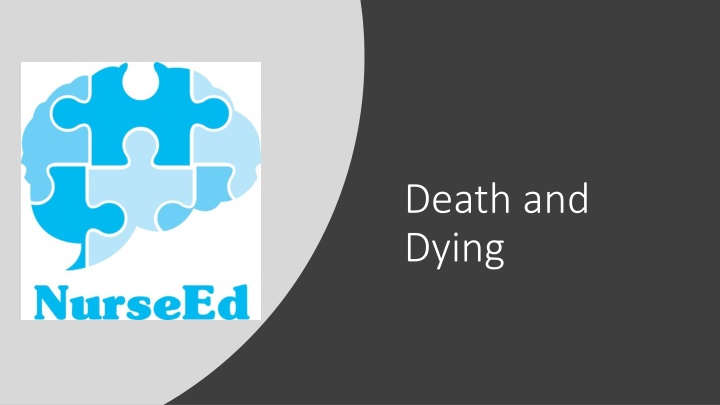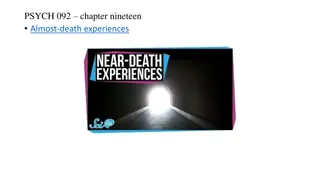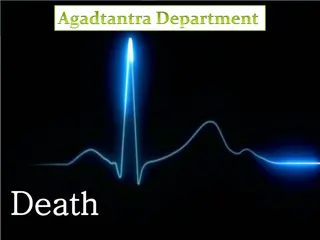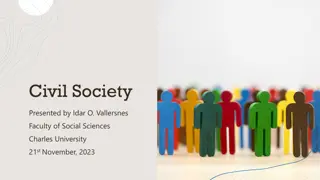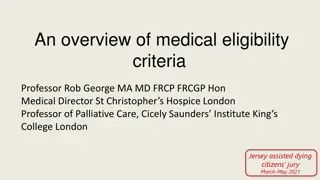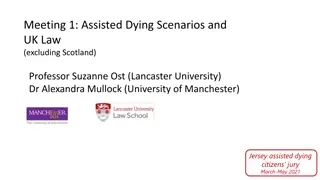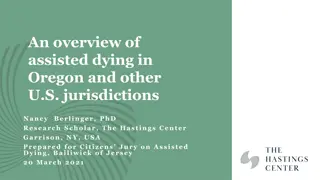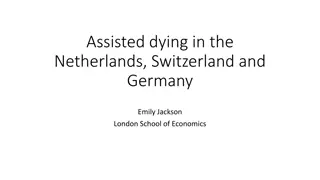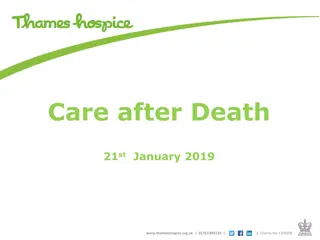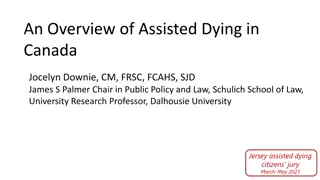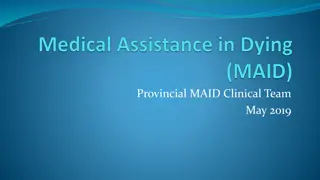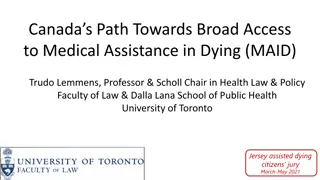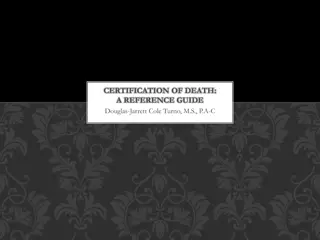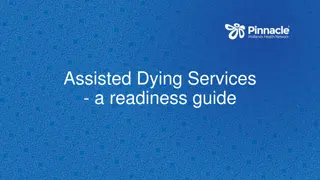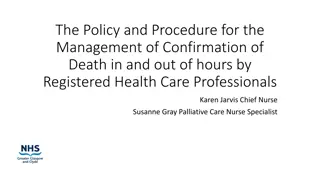Insights on Death and Dying in Modern Society
Shifting landscape of death and dying processes in the 21st century, from common causes of death to global disease impacts. Delve into the nuances of end-of-life experiences and societal perceptions.
Download Presentation

Please find below an Image/Link to download the presentation.
The content on the website is provided AS IS for your information and personal use only. It may not be sold, licensed, or shared on other websites without obtaining consent from the author.If you encounter any issues during the download, it is possible that the publisher has removed the file from their server.
You are allowed to download the files provided on this website for personal or commercial use, subject to the condition that they are used lawfully. All files are the property of their respective owners.
The content on the website is provided AS IS for your information and personal use only. It may not be sold, licensed, or shared on other websites without obtaining consent from the author.
E N D
Presentation Transcript
Death and Dying
A dying process that allows an individual to make choices about treatment, to say goodbyes and to take care of final arrangements is what many people hope for. Such a death might be considered a good death. But of course, many deaths do not occur in this way. Introduction to Death and Dying
In 1900, the most common causes of death were infectious diseases which brought death quickly. Today, the most common causes of death are chronic diseases in which a slow and steady decline in health ultimately results in death. How might this impact the way we think of death, how we grieve, and the amount of control a person has over his or her own dying process? Most Common Causes of Death The leading causes of death and number of deaths per category in 2004 in the United States are listed on the next slide. (National Vital Statistics Reports, Center for Disease Control, 2006).
Heart Disease (654,092) Malignant neoplasms (cancer) (550,270) Cerebrovascular disease (stroke) (150,147) Chronic lower respiratory disease (123,884) The leading causes of death and number of deaths per category in 2004 in the United States Accidents (123,884) Diabetes Mellitus (106.694) Alzheimer s Disease (72,815) Influenza and Pneumonia (65,829) Nephritis (61,472) Septicaemia (42,762) Suicide (33,464) Chronic Liver Disease (31,647) Hypertension and hypertensive renal disease (26,549) Parkinson s disease (22,953) Pneumonitis (18,018) These numbers reflect a change in Alzheimer s disease which moved up from the 8th leading cause of death to the 7th and influenza and pneumonia moved down in rank from 7th to 8th.
The top 12 deadliest diseases in the world are listed in the next slide along with the estimated number of deaths per cause. These figures are for 2002 and do not reflect deaths due to violence or suicide (World Health Organization, World Health Report, 2004). Deadliest Diseases Worldwide Notice the higher rates of death due to HIV/AIDS, perinatal conditions and diarrheal conditions than is found in the United States. Deaths of infants, young children, young mothers, and men and women in adolescence, young adulthood and midlife are more common. Many of these deaths are due to preventable causes. Ideas about the swiftness and unpredictable nature of death are certainly greater when living under such circumstances.
Heart disease (7.2 million) Cerebrovascular disease (5.5 million) Lower respiratory infections (3.9 million) HIV/AIDS (2.8 million) Deadliest Diseases Worldwide Chronic obstructive pulmonary (2.7 million) Perinatal conditions (2.5 million) Diarrheal diseases (1.8 million) Tuberculosis (1.6 million) Malaria (1.3 million) Trachea, bronchus, lung cancers (1.2 million) Road traffic accidents (1.2 million) Diabetes mellitus (1 million)
One way to understand death and dying is to look more closely at physical death, psychological death, and social death. These deaths do not occur simultaneously. Rather, a person s physiological, social, and psychic death can occur at different times (Pattison, 1977). The Process of Dying - Aspects of Death Physiological death occurs when the vital organs no longer function. The digestive and respiratory systems begin to shut down during the gradual process of dying. A dying person no longer wants to eat as digestion slows and the digestive track loses moisture and chewing, swallowing, and elimination become painful processes. Circulation slows and mottling or the pooling of blood may be noticeable on the underside of the body appearing much like bruising. Breathing becomes more sporadic and shallow and may make a rattling sound as air travels through mucus filled passageways. The person often sleeps more and more and may talk less although continues to hear. The kinds of symptoms noted prior to death in patients under hospice care (care focused on helping patients die as comfortably as possible) is noted in next slide.
Symptoms noted prior to death in patients under hospice care Percent
Begins much earlier than physiological death. Social death occurs when others begin to withdraw from someone who is terminally ill or has been diagnosed with a terminal illness. Those diagnosed with conditions such as AIDS or cancer may find that friends, family members, and even health care professionals begin to say less and visit less frequently. Meaningful discussions may be replaced with comments about the weather or other topics of light conversation. Doctors may spend less time with patients after their prognosis becomes poor. Why do others begin to withdraw? Friends and family members may feel that they do not know what to say or that they can offer no solutions to relieve suffering. Social death They withdraw to protect themselves against feeling inadequate or from having to face the reality of death. Health professionals, trained to heal, may also feel inadequate and uncomfortable facing decline and death. A patient who is dying may be referred to as circling the drain meaning that they are approaching death. People in nursing homes may live as socially dead for years with no one visiting or calling. Social support is important for quality of life and those who experience social death are deprived from the benefits that come from loving interaction with others.
Occurs when the dying person begins to accept death and to withdraw from others and regress into the self. This can take place long before physiological death (or even social death if others are still supporting and visiting the dying person) and can even bring physiological death closer. People have some control over the timing of their death and can hold on until after important occasions or die quickly after having lost someone important to them. They can give up their will to live Psychic death
Kubler-Ross (1969, 1975) describes five stages of loss experienced by someone who faces the news of their impending death. These stages are not really stages that a person goes through in order or only once; nor are they stages that occur with the same intensity. Indeed, the process of death is influenced by a person s life experiences, the timing of their death in relation to life events, the predictability of their death based on health or illness, their belief system, and their assessment of the quality of their own life. Five Stages of Loss Nevertheless, these stages help us to understand and recognize some of what a dying person experiences psychologically. And by understanding, we are more equipped to support that person as they die.
Is often the first reaction to overwhelming, unimaginable news. Denial, or disbelief or shock, protects us by allowing such news to enter slowly and to give us time to come to grips with what is taking place. The person who receives positive test results for life-threatening conditions may question the results, seek second opinions, or may simply feel a sense of disbelief psychologically even though they know that the results are true. 1.Denial
Also provides us with protection in that being angry energizes us to fight against something and gives structure to a situation that may be thrusting us into the unknown. It is much easier to be angry than to be sad or in pain or depressed. It helps us to temporarily believe that we have a sense of control over our future and to feel that we have at least expressed our rage about how unfair life can be. Anger can be focused on a person, a health care provider, at God, or at the world in general. And it can be expressed over issues that have nothing to do with our death; consequently, being in this stage of loss is not always obvious. 2. Anger
Involves trying to think of what could be done to turn the situation around. Living better, devoting self to a cause, being a better friend, parent, or spouse, are all agreements one might willingly commit to if doing so would lengthen life. Asking to just live long enough to witness a family event or finish a task are examples of bargaining. 3. Bargaining
Is sadness and sadness is appropriate for such an event. Feeling the full weight of loss, crying, and losing interest in the outside world is an important part of the process of dying. This depression makes others feel very uncomfortable and family members may try to console their loved one. Sometimes hospice care may include the use of antidepressants to reduce depression during this stage. 4. Depression
Involves learning how to carry on and to incorporate this aspect of the life span into daily existence. Reaching acceptance does not in any way imply that people who are dying are happy about it or content with it. It means that they are facing it and continuing to make arrangements and to say what they wish to say to others. Some terminally ill people find that they live life more fully than ever before after they come to this stage. We no longer think that there is a right way to experience the loss. People move through a variety of stages with different frequency and in various ways. 5. Acceptance
Focuses on providing comfort and relief from physical and emotional pain to patients throughout their illness even while being treated (NIH, 2007). Palliative care is part of hospice programs. Hospice involves caring for dying patients by helping them be as free from pain as possible, providing them with assistance to complete wills and other arrangements for their survivors, giving them social support through the psychological stages of loss, and helping family members cope with the dying process, grief, and bereavement. In order to enter hospice, a patient must be diagnosed as terminally ill with an anticipated death within 6 months. Most hospice care does not include medical treatment of disease or resuscitation although some programs administer curative care as well. Palliative care The patient is allowed to go through the dying process without invasive treatments. Family members, who have agreed to put their loved one on hospice, may become anxious when the patient begins to experience the death. They may believe that feeding or breathing tubes will sustain life and want to change their decision. Hospice workers try to inform the family of what to expect and reassure them that much of what they see is a normal part of the dying process.
Dame Cicely Saunders founded the hospice movement in Great Britain and described the kinds of pain experienced by those who are dying and their families. These 7 Pains include emotional include physical pain, spiritual pain, intellectual pain, emotional pain, interpersonal pain, financial pain and bureaucratic pain. Hospice care focuses on alleviating physical pain and providing spiritual guidance. Those suffering from Alzheimer s also experience intellectual pain and frustration as they lose their ability to remember and recognize others. Depression, anger, and frustration are elements of emotional pain, and family members can have tensions that a social worker or clergy member may be able to help resolve. Many patients are concerned with the financial burden their care will create for family members. And bureaucratic pain is also suffered while trying to submit bills and get information about health care benefits or to complete requirements for other legal matters. All of these concerns can be addressed by hospice care teams. Palliative care
Or helping a person fulfil their wish to die, can happen in two ways: voluntary euthanasia and physician-assisted suicide. Voluntary euthanasia refers to helping someone fulfil their wish to die by acting in such a way to help that person s life end. This can be passive euthanasia such as no longer feeding someone or giving them food. Or it can be active euthanasia such as administering a lethal dose of medication to someone who wishes to die. Euthanasia
Physician-assisted suicide occurs when a physician prescribes the means by which a person can end his or her own life. Physician-assisted suicide is legal in Oregon, the Netherlands, Switzerland, and Belgium. The Oregon Death with Dignity Act of 1997 grants physicians this right. Physician-assisted suicides, however, are rare. A growing number of the population support physician-assisted suicide. In 2000, a ruling of the U. S. Supreme Court upheld the right of states to determine their laws on physician-assisted suicide despite efforts to limit physicians ability to prescribe barbiturates and opiates for their patients requesting the means to end their lives. The position of the Supreme Court is that the debate concerning the morals and ethics surrounding the right to die is one that should be continued (Stein, 2000). As an increasing number of the population enters late adulthood, the emphasis on giving patients an active voice in determining certain aspects of their own death is likely. Physician- Assisted Suicide
Bereavement refers to outward expressions of grief. Mourning and funeral rites are expressions of loss that reflect personal and cultural beliefs about the meaning of death and the afterlife. Ceremonies provide survivors a sense of closure after a loss. These rites and ceremonies send the message that the death is real and allow friends and loved ones to express their love and duty to those who die. Under circumstances in which a person has been lost and presumed dead or when family members were unable to attend a funeral, there can continue to be a lack of closure that makes it difficult to grieve and to learn to live with loss. And although many people are still in shock when they attend funerals, the ceremony still provides a marker of the beginning of a new period of one s life as a survivor. Bereavement and Grief
Is the psychological, physical, and emotional experience of loss. The five stages of loss are experienced by those who are in grief (Kubler-Ross & Kessler, 2005). Grief reactions vary depending on whether a loss was anticipated or unexpected, (parents do not expect to lose their children, for example), and whether or not it occurred suddenly or after a long illness, and whether or not the survivor feels responsible for the death. Struggling with the question of responsibility is particularly felt by those who lose a loved one to suicide. There are numerous survivors for every suicide resulting in 4.5 million survivors of suicide in the United States (American Association of Suicidology, 2007). These survivors may torment themselves with endless what ifs in order to make sense of the loss and reduce feelings of guilt. Grief And family members may also hold one another responsible for the loss. The same may be true for any sudden or unexpected death making conflict an added dimension to grief. Much of this laying of responsibility is an effort to think that we have some control over these losses; the assumption being that if we do not repeat the same mistakes, we can control what happens in our life.
Occurs when a death is expected and survivors have time to prepare to some extent before the loss. Anticipatory grief can include the same denial, anger, bargaining, depression, and acceptance experienced in loss. This can make adjustment after a loss somewhat easier, although the stages of loss will be experienced again after the death (Kubler-Ross & Kessler, 2005). A death after a long-term, painful illness may bring family members a sense of relief that the suffering is over. The exhausting process of caring for someone who is ill is over. Disenfranchised grief may be experienced by those who have to hide the circumstances of their loss or whose grief goes unrecognized by others. Loss of an ex-spouse, lover, or pet may be examples of disenfranchised grief. Anticipatory grief Yet grief continues as long as there is a loss. It has been said that intense grief lasts about two years or less, but grief is felt throughout life. One loss triggers the feelings that surround another. People grieve with varied intensity throughout the remainder of their lives. It does not end. But it eventually becomes something that a person has learned to live with. As long as we experience loss, we experience grief (Kubler-Ross & Kessler, 2005). There are layers of grief. Initial denial, marked by shock and disbelief in the weeks following a loss may become an expectation that the loved one will walk in the door. And anger directed toward those who could not save our loved one s life, may become anger that life did not turn out as we expected. There is no right way to grieve. A bereavement counsellor expressed it well by saying that grief touches us on the shoulder from time to time throughout life.
Go hand in hand. A sense of relief is accompanied by regrets and periods of reminiscing about our loved ones are interspersed with feeling haunted by them in death. Our outward expressions of loss are also sometimes contradictory. We want to move on but at the same time are saddened by going through a loved one s possessions and giving them away. We may no longer feel sexual arousal or we may want sex to feel connected and alive. We need others to befriend us but may get angry at their attempts to console us. These contradictions are normal and we need to allow ourselves and others to grieve in their own time and in their own ways. Grief and mixed emotions
Is the modern world (Kubler-Ross & Kessler, 2005, p. 205). We are asked to grieve privately, quickly, and to medicate our suffering. Employers grant us 3 to 5 days for bereavement, if our loss is that of an immediate family member. And such leaves are sometimes limited to no more than one per year. Yet grief takes much longer and the bereaved are seldom ready to perform well on the job. Obviously life does have to continue. But Kubler- Ross and Kessler suggest that contemporary American society would do well to acknowledge and make more caring accommodations to those who are in grief. The death- denying, grief- dismissing world
Viewing death as an integral part of the lifespan will benefit those who are ill, those who are bereaved, and all of us as friends, caregivers, partners, family members and humans in a global society. Conclusion
